Calibrated Integral Equation Model for Bare Soil Moisture Retrieval of Synthetic Aperture Radar: A Case Study in Linze County
Abstract
1. Introduction
2. Study Area and Data
2.1. Study Area
2.2. Satellite Data and Preprocessing
2.3. Ground Measurements Data and Analysis
3. Model Construction
3.1. Integral Equation Model and Calibrated Integral Equation Model
3.2. Comparison between CIEM and IEM
3.3. Analysis of Simulated Backscattering Coefficient as Functions of Roughness and Soil Moisture
3.3.1. Effect of Hrms, Empirical Correlation Length lopt on the Backscattering Coefficient Using CIEM Simulations
3.3.2. Effect of Soil Moisture mv on the Backscattering Coefficient Using CIEM Simulations
3.4. Soil Moisture Retrieval Model
4. Results and discussion
5. Model Validation
6. Conclusions
Author Contributions
Funding
Acknowledgments
Conflicts of Interest
References
- Zhao, W.; Fang, X.; Daryanto, S.; Zhang, X.; Wang, Y.; Wenwu, Z.; Xuening, F.; Stefani, D.; Xiao, Z.; Yaping, W. Factors influencing soil moisture in the Loess Plateau, China: A review. Earth Environ. Sci. Trans. R. Soc. Edinb. 2018, 109, 501–509. [Google Scholar] [CrossRef]
- Liu, C.-A.; Chen, Z.-X.; Shao, Y.; Chen, J.-S.; Hasi, T.; Pan, H.-Z. Research advances of SAR remote sensing for agriculture applications: A review. J. Integr. Agric. 2019, 18, 506–525. [Google Scholar] [CrossRef]
- Lettenmaier, D.P.; Alsdorf, D.; Dozier, J.; Huffman, G.J.; Pan, M.; Wood, E.F. Inroads of remote sensing into hydrologic science during the WRR era. Water Resour. Res. 2015, 51, 7309–7342. [Google Scholar] [CrossRef]
- Karthikeyan, L.; Pan, M.; Wanders, N.; Kumar, D.N.; Wood, E.F. Four decades of microwave satellite soil moisture observations: Part 1. A review of retrieval algorithms. Adv. Water Resour. 2017, 109, 106–120. [Google Scholar] [CrossRef]
- Engman, E.T.; Chauhan, N. Status of microwave soil moisture measurements with remote sensing. Remote Sens. Environ. 1995, 51, 189–198. [Google Scholar] [CrossRef]
- Wang, J.; Hsu, A.; Shi, J.; O’Neill, P.; Engman, E. A comparison of soil moisture retrieval models using SIR-C measurements over the little Washita River watershed. Remote Sens. Environ. 1997, 59, 308–320. [Google Scholar] [CrossRef]
- Bousbih, S.; Zribi, M.; Lili-Chabaane, Z.; Baghdadi, N.; El Hajj, M.; Gao, Q.; Mougenot, B. Potential of Sentinel-1 Radar Data for the Assessment of Soil and Cereal Cover Parameters. Sensors 2017, 17, 2617. [Google Scholar] [CrossRef]
- Santi, E.; Dabboor, M.; Pettinato, S.; Paloscia, S. Combining Machine Learning and Compact Polarimetry for Estimating Soil Moisture from C-Band SAR Data. Remote Sens. 2019, 11, 2451. [Google Scholar] [CrossRef]
- Baghdadi, N.; El Hajj, M.; Choker, M.; Zribi, M.; Bazzi, H.; Vaudour, E.; Gilliot, J.-M.; Ebengo, D.M. Potential of Sentinel-1 Images for Estimating the Soil Roughness over Bare Agricultural Soils. Water 2018, 10, 131. [Google Scholar] [CrossRef]
- Zhang, X.; Chen, B.; Fan, H.; Huang, J.; Zhao, H. The Potential Use of Multi-Band SAR Data for Soil Moisture Retrieval over Bare Agricultural Areas: Hebei, China. Remote Sens. 2015, 8, 7. [Google Scholar] [CrossRef]
- Mirsoleimani, H.R.; Sahebi, M.R.; Baghdadi, N.; El Hajj, M. Bare Soil Surface Moisture Retrieval from Sentinel-1 SAR Data Based on the Calibrated IEM and Dubois Models Using Neural Networks. Sensors 2019, 19, 3209. [Google Scholar] [CrossRef]
- Tao, L.; Wang, G.; Chen, W.; Li, J.; Cai, Q. Soil Moisture Retrieval from SAR and Optical Data Using a Combined Model. IEEE J. Sel. Topics Appl. Earth Obs. Remote Sens. 2019, 12, 637–647. [Google Scholar] [CrossRef]
- Foucras, M.; Zribi, M.; Albergel, C.; Baghdadi, N.; Calvet, J.-C.; Pellarin, T. Estimating 500-m Resolution Soil Moisture Using Sentinel-1 and Optical Data Synergy. Water 2020, 12, 866. [Google Scholar] [CrossRef]
- Bousbih, S.; Zribi, M.; El Hajj, M.; Baghdadi, N.; Lili-Chabaane, Z.; Gao, Q.; Fanise, P. Soil Moisture and Irrigation Mapping in A Semi-Arid Region, Based on the Synergetic Use of Sentinel-1 and Sentinel-2 Data. Remote Sens. 2018, 10, 1953. [Google Scholar] [CrossRef]
- El Hajj, M.; Baghdadi, N.; Zribi, M.; Bazzi, H. Synergic Use of Sentinel-1 and Sentinel-2 Images for Operational Soil Moisture Mapping at High Spatial Resolution over Agricultural Areas. Remote Sens. 2017, 9, 1292. [Google Scholar] [CrossRef]
- Gao, Q.; Zribi, M.; Escorihuela, M.J.; Baghdadi, N. Synergetic Use of Sentinel-1 and Sentinel-2 Data for Soil Moisture Mapping at 100 m Resolution. Sensors 2017, 17, 1966. [Google Scholar] [CrossRef]
- Huang, S.; Ding, J.; Zou, J.; Liu, B.; Zhang, J.; Chen, W. Soil Moisture Retrival Based on Sentinel-1 Imagery under Sparse Vegetation Coverage. Sensors 2019, 19, 589. [Google Scholar] [CrossRef]
- Zhang, L.; Lv, X.; Chen, Q.; Sun, G.-C.; Yao, J. Estimation of Surface Soil Moisture during Corn Growth Stage from SAR and Optical Data Using a Combined Scattering Model. Remote Sens. 2020, 12, 1844. [Google Scholar]
- El Hajj, M.; Baghdadi, N.; Zribi, M.; Belaud, G.; Cheviron, B.; Courault, D.; Charron, F. Soil moisture retrieval over irrigated grassland using X-band SAR data. Remote Sens. Environ. 2016, 176, 202–218. [Google Scholar] [CrossRef]
- Baghdadi, N.; El Hajj, M.; Zribi, M.; Bousbih, S. Calibration of the Water Cloud Model at C-Band for Winter Crop Fields and Grasslands. Remote Sens. 2017, 9, 969. [Google Scholar] [CrossRef]
- Verhoest, N.E.C.; Lievens, H.; Wagner, W.; Álvarez-Mozos, J.; Moran, M.S.; Mattia, F. On the Soil Roughness Parameterization Problem in Soil Moisture Retrieval of Bare Surfaces from Synthetic Aperture Radar. Sensors 2008, 8, 4213–4248. [Google Scholar] [CrossRef]
- Rahman, M.; Moran, M.; Thoma, D.; Bryant, R.; Collins, C.H.; Jackson, T.; Orr, B.; Tischler, M. Mapping surface roughness and soil moisture using multi-angle radar imagery without ancillary data. Remote Sens. Environ. 2008, 112, 391–402. [Google Scholar] [CrossRef]
- Baghdadi, N.; King, C.; Chanzy, A.; Wigneron, J.P. An empirical calibration of the integral equation model based on SAR data, soil moisture and surface roughness measurement over bare soils. Int. J. Remote Sens. 2002, 23, 4325–4340. [Google Scholar] [CrossRef]
- Zribi, M.; Gorrab, A.; Baghdadi, N. A new soil roughness parameter for the modelling of radar backscattering over bare soil. Remote Sens. Environ. 2014, 152, 62–73. [Google Scholar] [CrossRef]
- Satalino, G.; Mattia, F.; Davidson, M.; Le Toan, T.; Pasquariello, G.; Borgeaud, M. On current limits of soil moisture retrieval from ERS-SAR data. IEEE Trans. Geosci. Remote Sens. 2002, 40, 2438–2447. [Google Scholar] [CrossRef]
- Mattia, F.; Le Toan, T. Backscattering Properties of Multi-Scale Rough Surfaces. J. Electromagn. Waves Appl. 1999, 13, 419–526. [Google Scholar] [CrossRef]
- Zribi, M.; Ciarletti, V.; Taconet, O. Validation of a Rough Surface Model Based on Fractional Brownian Geometry with SIRC and ERASME Radar Data over Orgeval. Remote Sens. Environ. 2000, 73, 65–72. [Google Scholar] [CrossRef]
- Davenport, I.; Holden, N.; Pentreath, R. Derivation of soil surface properties from airborne laser altimetry. In Proceedings of the International Geoscience and Remote Sensing Symposium (IGARSS ’03), Toulouse, France, 21–25 July 2003; pp. 438–4391. [Google Scholar]
- Davenport, I.; Holden, N.; Gurney, R. Characterizing errors in airborne laser altimetry data to extract soil roughness. IEEE Trans. Geosci. Remote Sens. 2004, 42, 2130–2141. [Google Scholar] [CrossRef]
- Hajnsek, I.; Pottier, E.; Cloude, S. Inversion of surface parameters from polarimetric SAR. IEEE Trans. Geosci. Remote Sens. 2003, 41, 727–744. [Google Scholar] [CrossRef]
- Schuler, D.; Lee, J.-S.; Kasilingam, D.; Nesti, G. Surface roughness and slope measurements using polarimetric SAR data. IEEE Trans. Geosci. Remote Sens. 2002, 40, 687–698. [Google Scholar] [CrossRef]
- Baghdadi, N.; Choker, M.; Zribi, M.; El Hajj, M.; Paloscia, S.; Verhoest, N.E.C.; Lievens, H.; Frappart, F.; Mattia, F. A New Empirical Model for Radar Scattering from Bare Soil Surfaces. Remote Sens. 2016, 8, 14. [Google Scholar] [CrossRef]
- Fung, A.; Li, Z.; Chen, K. Backscattering from a randomly rough dielectric surface. IEEE Trans. Geosci. Remote Sens. 1992, 30, 356–369. [Google Scholar] [CrossRef]
- Baghdadi, N.; Gherboudj, I.; Zribi, M.; Sahebi, M.; King, C.; Bonn, F. Semi-empirical calibration of the IEM backscattering model using radar images and moisture and roughness field measurements. Int. J. Remote Sens. 2004, 25, 3593–3623. [Google Scholar] [CrossRef]
- Baghdadi, N.; Holah, N.; Zribi, M. Calibration of the Integral Equation Model for SAR data in C-band and HH and VV polarizations. Int. J. Remote Sens. 2006, 27, 805–816. [Google Scholar] [CrossRef]
- Baghdadi, N.; Chaaya, J.A.; Zribi, M. Semiempirical Calibration of the Integral Equation Model for SAR Data in C-Band and Cross Polarization Using Radar Images and Field Measurements. IEEE Geosci. Remote Sens. Lett. 2010, 8, 14–18. [Google Scholar] [CrossRef]
- Baghdadi, N.; Saba, E.; Aubert, M.; Zribi, M.; Baup, F. Evaluation of Radar Backscattering Models IEM, Oh, and Dubois for SAR Data in X-Band Over Bare Soils. IEEE Geosci. Remote Sens. Lett. 2011, 8, 1160–1164. [Google Scholar] [CrossRef]
- Baghdadi, N.; Zribi, M.; Paloscia, S.; Verhoest, N.E.C.; Lievens, H.; Baup, F.; Mattia, F. Semi-Empirical Calibration of the Integral Equation Model for Co-Polarized L-Band Backscattering. Remote Sens. 2015, 7, 13626–13640. [Google Scholar] [CrossRef]
- Chen, K.; Wu, T.-D.; Tsang, L.; Li, Q.; Shi, J.; Fung, A. Emission of rough surfaces calculated by the integral equation method with comparison to three-dimensional moment method simulations. IEEE Trans. Geosci. Remote Sens. 2003, 41, 90–101. [Google Scholar] [CrossRef]
- Zribi, M.; Dechambre, M. A new empirical model to retrieve soil moisture and roughness from C-band radar data. Remote Sens. Environ. 2003, 84, 42–52. [Google Scholar] [CrossRef]
- Tao, L.; Chen, X.; Cai, Q.; Zhang, Y.; Li, J. An Effective Model to Retrieve Soil Moisture from L- and C-Band SAR Data. J. Indian Soc. Remote Sens. 2016, 45, 621–629. [Google Scholar] [CrossRef]
- Yu, F.; Zhao, Y.S. A new method for soil moisture inversion by synthetic aperture radar. Geomatics. Inf. Sci. Wuhan Univ. 2010, 35, 317–321. [Google Scholar]
- Kong, J.L. Retrieval for soil moisture using microwave remote sensing data based on a new combined roughness parameter. Geogr. Geo-Inf. 2016, 32, 34–38. [Google Scholar]
- Yang, L.; Li, Y.; Li, Q.; Sun, X.; Kong, J.; Wang, L. Implementation of a multiangle soil moisture retrieval model using RADARSAT-2 imagery over arid Juyanze, northwest China. J. Appl. Remote Sens. 2017, 11, 036029. [Google Scholar] [CrossRef]
- Kong, J.; Yang, J.; Zhen, P.; Li, J.; Yang, L. A Coupling Model for Soil Moisture Retrieval in Sparse Vegetation Covered Areas Based on Microwave and Optical Remote Sensing Data. IEEE Trans. Geosci. Remote Sens. 2018, 56, 7162–7173. [Google Scholar] [CrossRef]
- Yu, F.; Li, H.T.; Zhang, C.M.; Wan, Z.; Liu, J.; Zhao, Y. A new approach for surface soil moisture retrieving using two-polarized microwave remote sensing data. Geomat. Inf. Sci. Wuhan Univ. 2014, 39, 225–228. [Google Scholar]
- Huang, D.; Wang, W. Surface soil moisture estimation using IEM model with calibrated roughness. Trans. Chin. Soc. Agric. Eng. (Trans. CSAE) 2014, 30, 182–190. [Google Scholar]
- Chen, L.W.; Han, L. A New Method for Constructing Land Surface Combined Roughness Parameter in the Process of Soil Moisture Retrieval by Microwave Remote Sensing. Geogr. Geo-Inf. Sci. 2017, 33, 37–43. [Google Scholar]
- Guo, S.; Bai, X.; Chen, Y.; Zhang, S.; Hou, H.; Zhu, Q.; Du, P. An Improved Approach for Soil Moisture Estimation in Gully Fields of the Loess Plateau Using Sentinel-1A Radar Images. Remote Sens. 2019, 11, 349. [Google Scholar] [CrossRef]
- Jun, C.; Ban, Y.; Li, S. Open access to Earth land-cover map. Nat. Cell Biol. 2014, 514, 434. [Google Scholar] [CrossRef]
- WATER: Dataset of ground truth measurements synchronizing with Envisat ASAR and ALOS PALSAR in the Linze station foci experimental area on May 24, 2008. Natl. Tibetan Plateau Data Cent. 2013. [CrossRef]
- Ge, C.M. WATER: Dataset of ground truth measurements synchronizing with Envisat ASAR in the Linze grassland foci experimental area on Jul. 11, 2008. Natl. Tibetan Plateau Data Cent. 2013. [Google Scholar] [CrossRef]
- Wang, S.G.; Li, X.; Han, X.J.; Jin, R. Estimation of surface soil moisture and roughness from multi-angular ASAR imagery in the Watershed Allied Telemetry Experimental Research (WATER). Hydrol. Earth Syst. Sci. 2011, 15, 1415–1426. [Google Scholar] [CrossRef]
- FUNG, A.K. Microwave Scattering and Emission Models for Users; Artech House Inc.: Boston, MA, USA; London, UK, 1994; pp. 47–328. [Google Scholar]
- Choker, M.; Baghdadi, N.; Zribi, M.; El Hajj, M.; Paloscia, S.; Verhoest, N.; Lievens, H.; Mattia, F. Evaluation of the Oh, Dubois and IEM models using large dataset of SAR signal and experimental soil measurements. Water 2017, 9, 38. [Google Scholar] [CrossRef]
- Zhang, X.; Chen, B.; Zhao, H.; Li, T.; Chen, Q. Physical-based soil moisture retrieval method over bare agricultural areas by means of multi-sensor SAR data. Int. J. Remote Sens. 2018, 39, 3870–3890. [Google Scholar] [CrossRef]
- Shi, J.; Wang, J.; Hsu, A.; O’Neill, P.; Engman, E. Estimation of bare surface soil moisture and surface roughness parameter using L-band SAR image data. IEEE Trans. Geosci. Remote Sens. 1997, 35, 1254–1266. [Google Scholar]
- Zribi, M.; Baghdadi, N.; Holah, N.; Fafin, O. New methodology for soil surface moisture estimation and its application to ENVISAT-ASAR multi-incidence data inversion. Remote Sens. Environ. 2005, 96, 485–496. [Google Scholar] [CrossRef]
- Oh, Y.; Hong, J.-Y. Effect of Surface Profile Length on the Backscattering Coefficients of Bare Surfaces. IEEE Trans. Geosci. Remote Sens. 2007, 45, 632–638. [Google Scholar] [CrossRef]
- Baghdadi, N.; King, C.; Bourguignon, A.; Remond, A. Potential of ERS and Radarsat data for surface roughness monitoring over bare agricultural fields: Application to catchments in Northern France. Int. J. Remote Sens. 2002, 23, 3427–3442. [Google Scholar] [CrossRef]


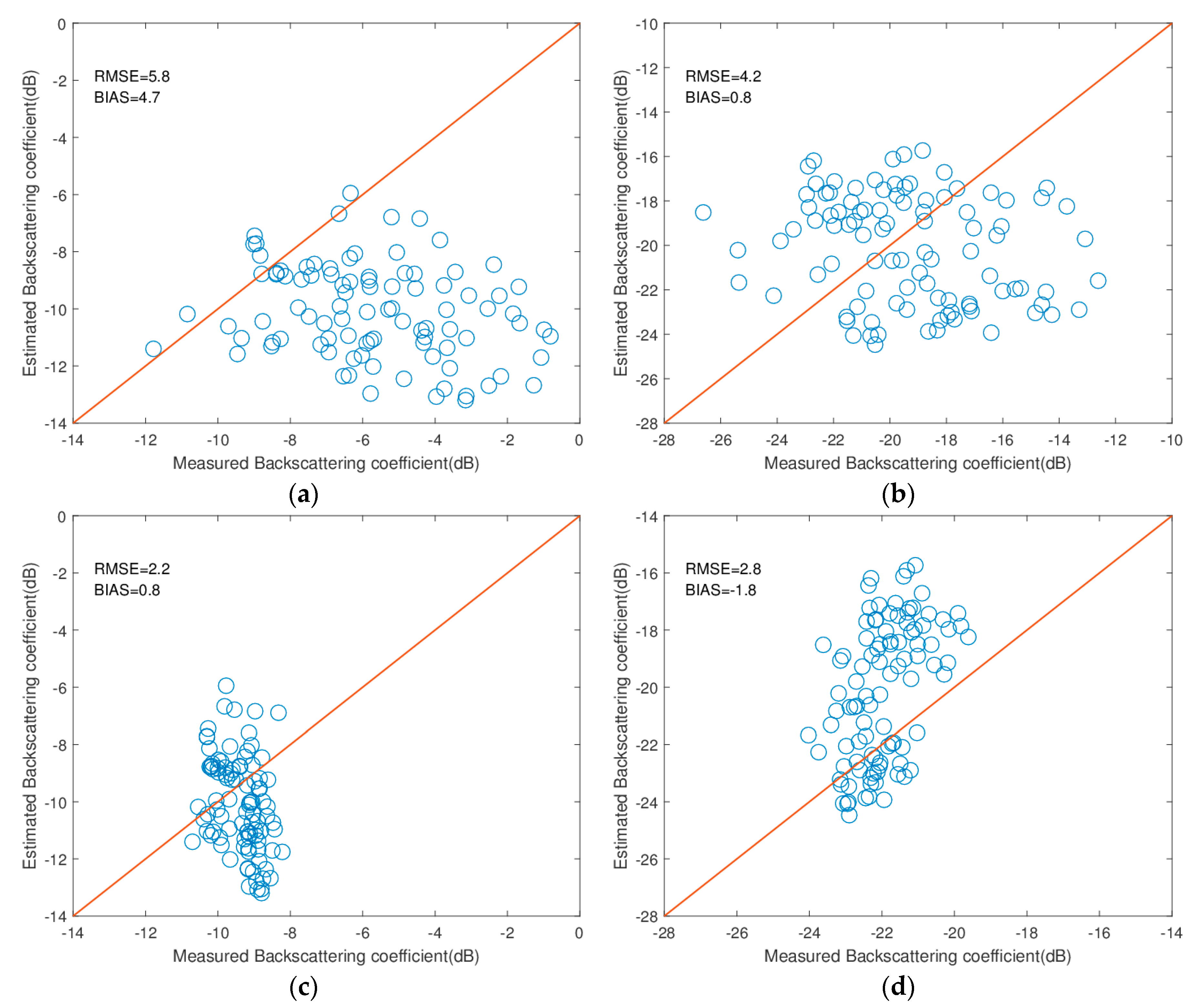
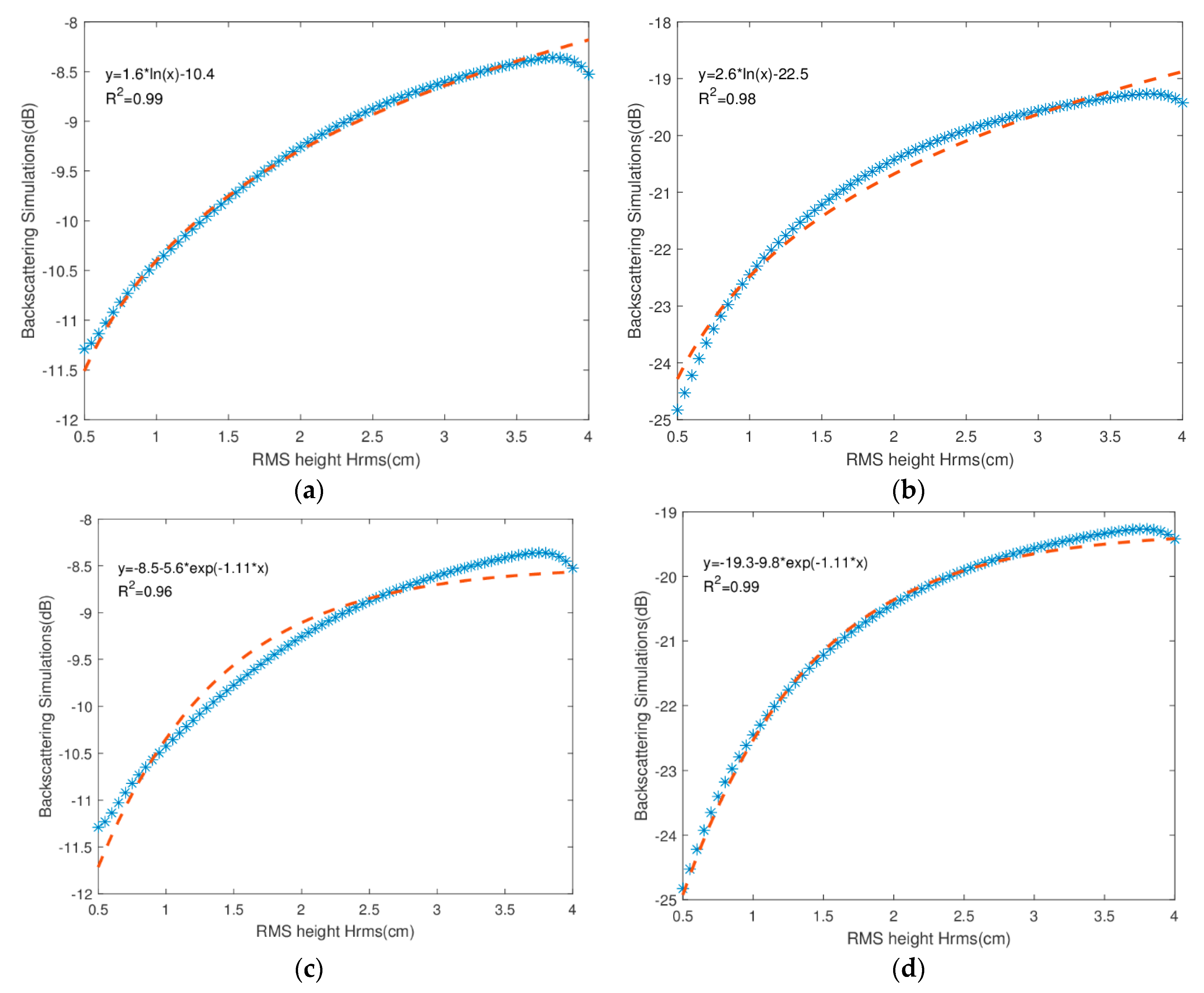

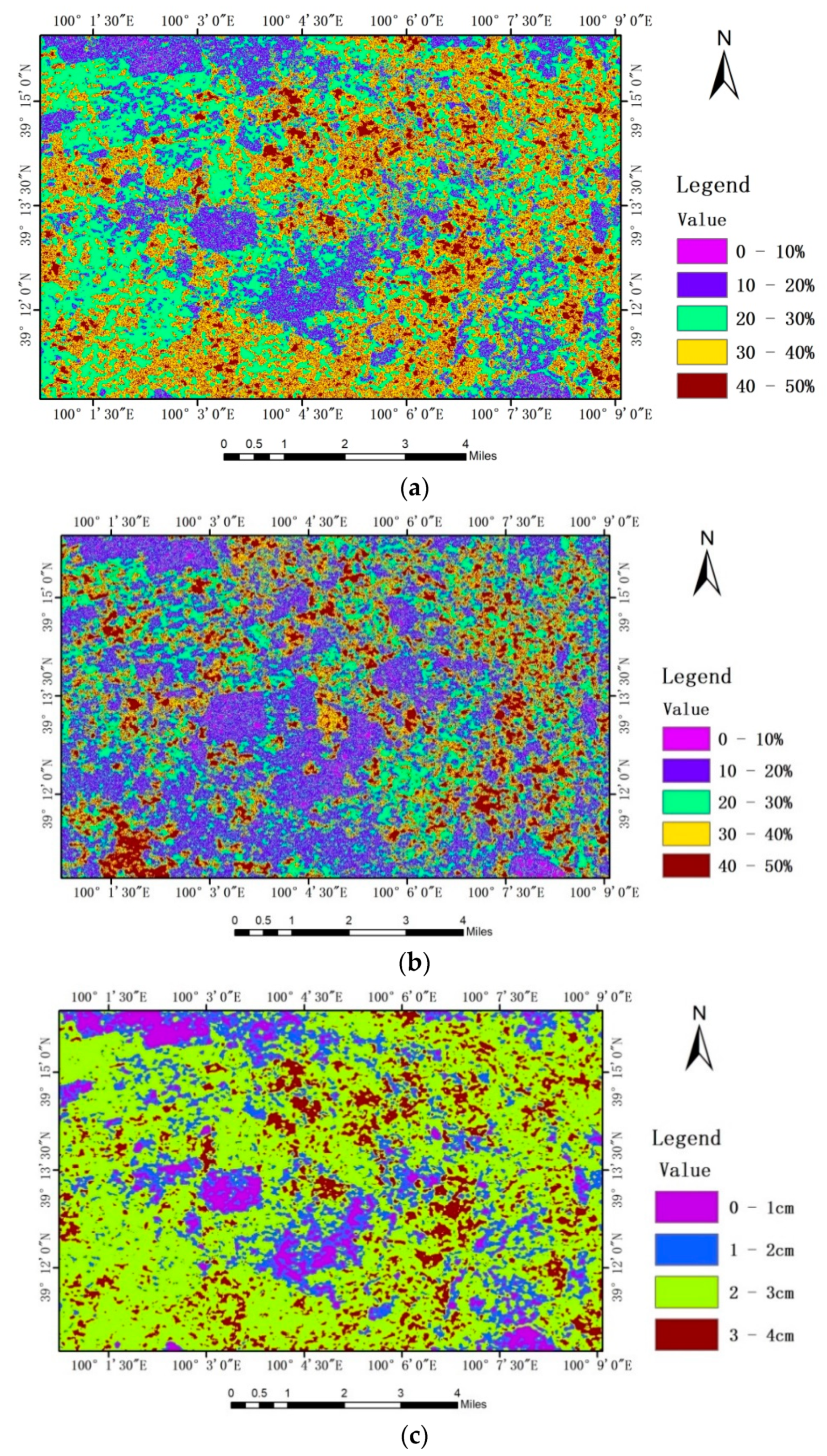
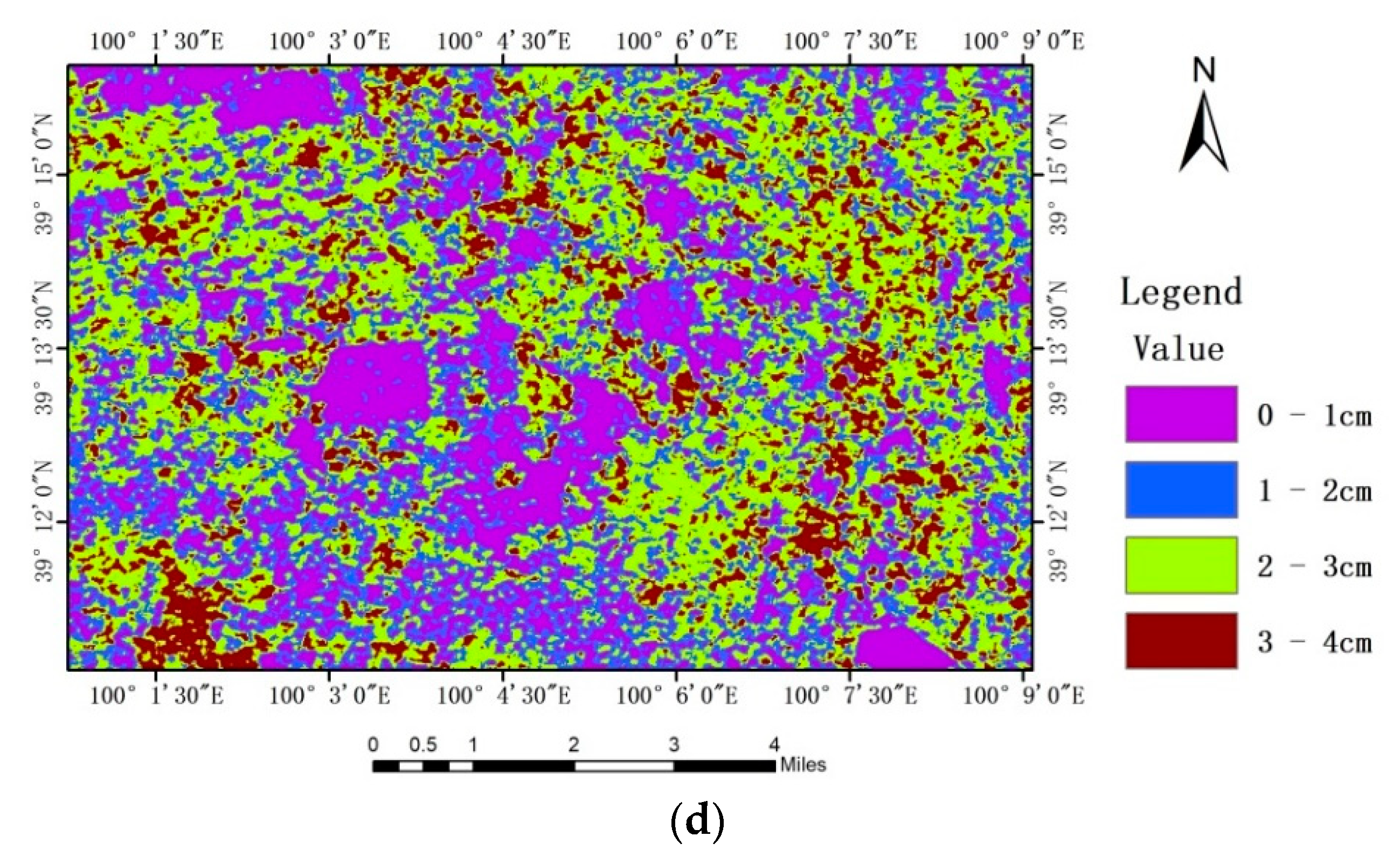
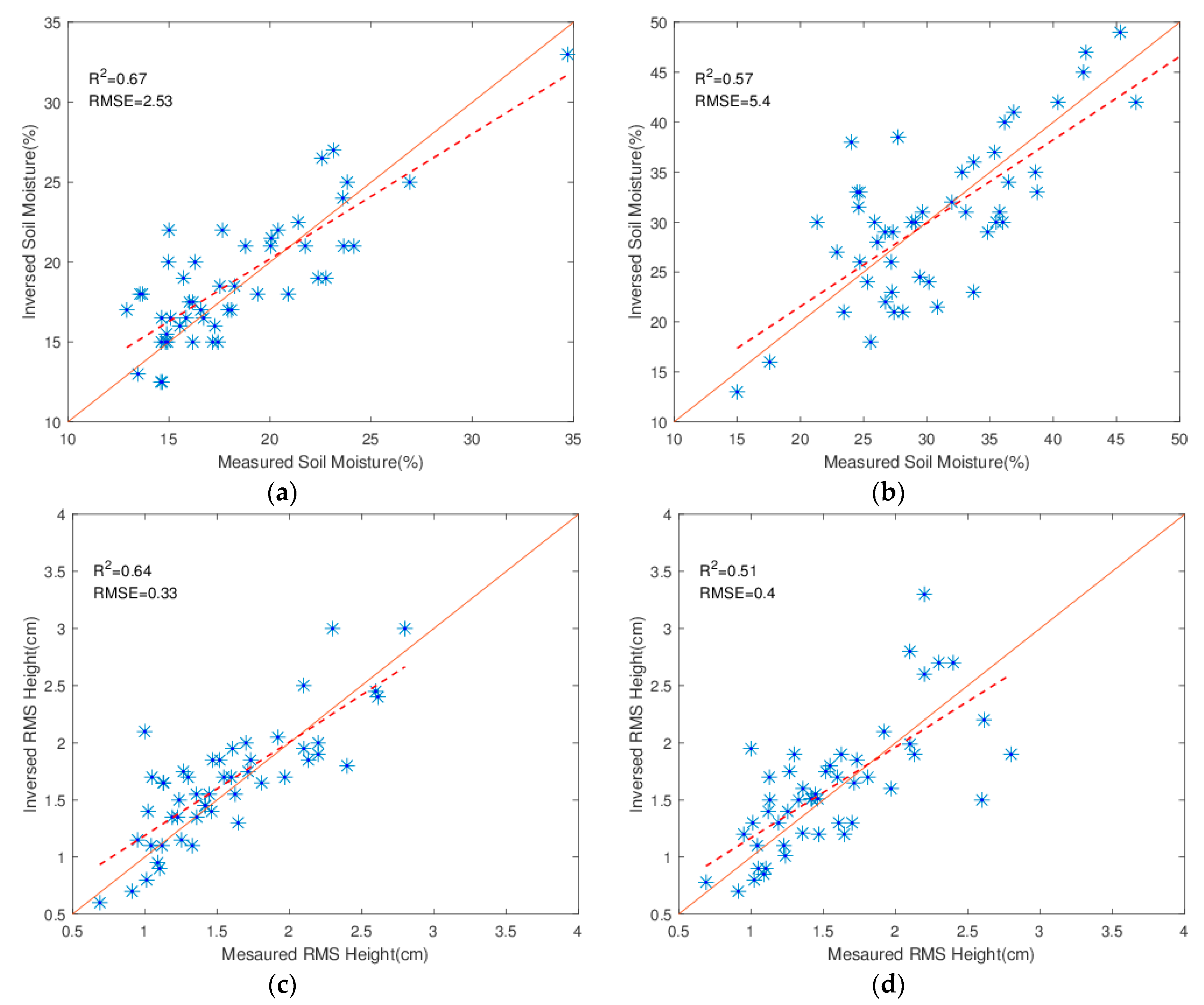
| Authors | Data Source | Model Used | Surface Roughness Parameterization |
|---|---|---|---|
| Zribi (2003) [40] | SIRC/X-SAR, ERASME, RADARSAT | IEM | Zs = s2/l |
| Yu (2010) [46] | ASAR | AIEM | Zs = s3/l2 |
| Huang (2014) [47] | ENVISAT-ASAR | CIEM | Zs = s2/lopt |
| Tao (2017) [41] | ALOS/PALSAR, RADARSAT-2 | IEM | Zs = s2.33/l1.33 |
| Chen (2017) [48] | ASAR | AIEM | Zs = s3 + bs2l + cs2 + dsl + es + fl |
| Kong (2018) [45] | Radarsat-2 | AIEM | Zs = s3/l |
| Yang (2019) [44] | RADARSAT-2 | AIEM | Zs = s3/l2 |
| Guo (2019) [49] | Sentinel-1 | AIEM | Zs = s/l |
| This Study | ASAR | CIEM | S,lopt |
| Satellite Data Description | ||||
| Satellite Data | Polarization | Band | Acquisition Date | Incidence Angle (°) |
| ENVISAT/ASAR ENVISAT/ASAR | VV/VH VV/VH | C C | 11 July 2008 24 May 2008 | 33.5° 26.3° |
| Ground Measurements Data | ||||
| Min | Max | Average | Observation Time | |
| Soil moisture (%) | 13.5 | 34.7 | 18.6 | 11 July 2008 |
| Soil moisture (%) | 17.6 | 50.7 | 24.7 | 24 May 2008 |
| Hrms (cm) | 0.68 | 4.08 | 1.4 | 7 June 2008 |
| Correlation length (cm) | 53 | 69 | 63.2 | 7 June 2008 |
| θ (°) | a (θ) | b (θ) | c (θ) | d (θ) | R2 |
|---|---|---|---|---|---|
| 25 | 0.0032 | 0.0258 | −9.592 × 10−5 | 0.104 | 0.57 |
| 26.3 | 0.0032 | 0.0286 | 1.973 × 10−4 | 0.1007 | 0.72 |
| 30 | 0.0031 | 0.0337 | 0.0008 | 0.0916 | 0.95 |
| 33.5 | 0.0030 | 0.0354 | 0.0011 | 0.0838 | 0.98 |
| 35 | 0.0030 | 0.0355 | 0.0012 | 0.0808 | 0.98 |
| 40 | 0.0029 | 0.0349 | 0.0014 | 0.0720 | 0.98 |
| 45 | 0.0028 | 0.0337 | 0.0015 | 0.0643 | 0.97 |
| 50 | 0.0028 | 0.0317 | 0.0017 | 0.0573 | 0.96 |
| 55 | 0.0029 | 0.0283 | 0.0018 | 0.0505 | 0.94 |
| θ (°) | a (θ) | b (θ) | c (θ) | d (θ) | R2 |
|---|---|---|---|---|---|
| 25 | 0.0001 | 0.0028 | 2.768 × 10−5 | 0.005 | 0.79 |
| 26.3 | 0.0002 | 0.0031 | 4.718 × 10−5 | 0.0051 | 0.86 |
| 30 | 0.0002 | 0.0037 | 9.666 × 10−5 | 0.005 | 0.97 |
| 33.5 | 0.0002 | 0.0041 | 0.0001 | 0.0053 | 0.99 |
| 35 | 0.0002 | 0.0042 | 0.0001 | 0.0053 | 0.99 |
| 40 | 0.0002 | 0.0045 | 0.0002 | 0.0053 | 0.99 |
| 45 | 0.0002 | 0.0046 | 0.0002 | 0.0051 | 0.99 |
| 50 | 0.0002 | 0.0045 | 0.0002 | 0.0048 | 0.98 |
| 55 | 0.0002 | 0.0041 | 0.0003 | 0.0043 | 0.98 |
| θ (°) | a (θ) | b (θ) | c (θ) | d (θ) | R2 |
|---|---|---|---|---|---|
| 25 | 0.0037 | 0.0289 | 0.0010 | 0.1018 | 0.97 |
| 30 | 0.0032 | 0.0323 | 0.0011 | 0.0909 | 0.98 |
| 35 | 0.0030 | 0.0320 | 0.0012 | 0.0809 | 0.98 |
| 40 | 0.0029 | 0.0303 | 0.0012 | 0.0723 | 0.98 |
| 45 | 0.0028 | 0.0280 | 0.0012 | 0.0648 | 0.97 |
| 50 | 0.0028 | 0.0252 | 0.0012 | 0.0580 | 0.97 |
| 55 | 0.0029 | 0.0211 | 0.0012 | 0.0541 | 0.96 |
| θ (°) | a (θ) | b (θ) | c (θ) | d (θ) | R2 |
|---|---|---|---|---|---|
| 25 | 0.0002 | 0.0032 | 0.0001 | 0.0049 | 0.99 |
| 30 | 0.0002 | 0.0038 | 0.0001 | 0.0052 | 0.99 |
| 35 | 0.0002 | 0.0040 | 0.0002 | 0.0053 | 0.99 |
| 40 | 0.0002 | 0.0042 | 0.0002 | 0.0053 | 0.99 |
| 45 | 0.0002 | 0.0042 | 0.0002 | 0.0051 | 0.99 |
| 50 | 0.0002 | 0.0039 | 0.0002 | 0.0049 | 0.99 |
| 55 | 0.0002 | 0.0035 | 0.0002 | 0.0044 | 0.99 |
Publisher’s Note: MDPI stays neutral with regard to jurisdictional claims in published maps and institutional affiliations. |
© 2020 by the authors. Licensee MDPI, Basel, Switzerland. This article is an open access article distributed under the terms and conditions of the Creative Commons Attribution (CC BY) license (http://creativecommons.org/licenses/by/4.0/).
Share and Cite
Zhang, L.; Li, H.; Xue, Z. Calibrated Integral Equation Model for Bare Soil Moisture Retrieval of Synthetic Aperture Radar: A Case Study in Linze County. Appl. Sci. 2020, 10, 7921. https://doi.org/10.3390/app10217921
Zhang L, Li H, Xue Z. Calibrated Integral Equation Model for Bare Soil Moisture Retrieval of Synthetic Aperture Radar: A Case Study in Linze County. Applied Sciences. 2020; 10(21):7921. https://doi.org/10.3390/app10217921
Chicago/Turabian StyleZhang, Ling, Hao Li, and Zhaohui Xue. 2020. "Calibrated Integral Equation Model for Bare Soil Moisture Retrieval of Synthetic Aperture Radar: A Case Study in Linze County" Applied Sciences 10, no. 21: 7921. https://doi.org/10.3390/app10217921
APA StyleZhang, L., Li, H., & Xue, Z. (2020). Calibrated Integral Equation Model for Bare Soil Moisture Retrieval of Synthetic Aperture Radar: A Case Study in Linze County. Applied Sciences, 10(21), 7921. https://doi.org/10.3390/app10217921





